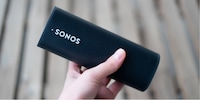

Sonos Beam: the new Multiroom niche
Sonos has presented the Sonos Beam to journalists. The first impression is certainly convincing, but the new mini soundbar also raises a lot of questions, mainly linked to the fact that the market for small soundbars doesn't even exist yet. Sonos is trying to create a niche for itself.
"If it's a big home cinema you want, the Beam is probably not what you need," says Ross Barbour, Training Manager EMEA at Sonos.
He shows off the latest addition to the Sonos range in a specially hired studio in Zurich. We find the Sonos Beam in white in front of a TV and in black on a table. It's no more impressive than any other small sound bar. This is a marketing problem that affects televisions and speakers in general. Where smartphones occasionally cause a stir with bold design choices - love them or hate them? - speakers and televisions, with a few exceptions, are designed in such a way as not to attract attention in a flat. The Beam is no exception. Compact, rounded, plain colour.
But the Sonos Beam becomes much more interesting when you unpack the Training Manager's statement: Sonos is indulging in something daring, unheard of in the world of Multiroom.
The Multiroom system niche
Until now, you didn't have much choice in terms of a Multiroom system: more bass, less bass, small speakers, big speakers. That's pretty much it. The Sonos Beam wants to do things differently.
According to Barbour, the Beam is not a replacement for the Playbar, which, combined with a subwoofer and possibly a pair of Play 1 speakers, forms a home cinema system. Of course, that's also possible, but the Beam isn't designed to boost sound in large, open rooms.
"The Beam is there to fill small rooms with intense, quality sound," says the Training Manager.
It's a model that's made more for the bedroom than the living room of a detached house in the suburbs, and also more for the living room of a city flat than a large open loft. The Beam is ideal for those who live in the city, aren't rolling in dough and are rather trendy.
Let's see what it's got
As exciting as the Beam's market positioning is, it's not about whether you're in its target group or not. It's about the sound it makes when you want to listen to something. It's also about putting into perspective what Barbour meant by 'not for you'. The studio in which he talks to media representatives sitting on a sofa is not a small city flat. It's more like a big loft. In this room, laboratory conditions cannot really be reproduced, or only to a limited extent. Even the projector screen, which has been pulled down from the ceiling to better reflect the sound in the small simulated living room isn't much help, admits Ross.
On an iPad, he presses "Play", music blares. The four speakers deliver bass and midrange, the tweeter at the front ensures clear voice reproduction. The setup looks a lot like a TV soundbar, but Ross puts it into perspective.
"The Beam is able to distinguish between music and TV content, and automatically adjusts the EQs," he says.
We can better understand what he was getting at with a scene from the Hollywood film "First Contact". Amy Adams meets the heptopods for the first time in the role of Louise Banks, the expert in comparative linguistics. The soundtrack by Iceland's Jóhann Jóhannsson is dominated by long, deep bass, and Louise speaks almost in a whisper. The hairs stand up on the journalists' arms, mission accomplished.
Idem for the Radiohead track Ross played from the iPad. The Sonos system has adapted. The tweeter is no longer as dominant, the four woofers - not to be confused with a subwoofer, which specialises in bass - deliver more and the three passive bass radiators perform better.
"Okay, Radiohead might have more of an advantage here," Ross laughs, "Nigel Godrich is in our sound board."
That sound board is made up of big names in music and film. As well as Radiohead's producer, there's also film composer Hans Zimmer and others. They contribute their expertise to the development of the loudspeakers, which have to be able to do everything as well as possible. So you have to wonder if the Sonos speakers were essentially optimised for the sound of Radiohead and films like Dunkirk, and too bad for everyone else? We hope to answer the question in the test.
The soundbar has a built-in night mode that's supposed to spare your neighbours when you're watching movies or listening to music at night.
And what else?
In the little sound bar, there are not only speakers, but also microphones. The latter are used to integrate voice assistants. Amazon's, Alexa, is permanently installed, with the Google assistant due to arrive again this year. This is very interesting for us, because Alexa is only available in Switzerland through workarounds and doesn't have all the features. Let me give you an example. Ask Alexa and the Google assistant the following question: "What's the weather?"
- Google: "Today in Zürich, it's 24 degrees and sunny. Currently, it's 18 degrees and clear sky"
- Amazon: "I don't know the answer to that one. Please input your address into the Alexa App"
Even if you enter the address into the app, Alexa can't yet answer for Switzerland. But when you ask Alexa about "The weather in Zürich, Switzerland", it tells you what the weather is like. So, in Switzerland, we prefer Google's voice assistant to Amazon's Alexa. Of course, Siri will also be integrated into Sonos products.

The voice assistant integration is interesting because you can connect the Beam to your TV via HDMI ARC and the Beam can then interact with the TV's functions. So "Alexa, turn on the TV" works, even if your TV is a few years old. HDMI ARC has been around for a few years now, but hasn't yet been given much attention. ARC stands for Audio Return Channel and enables the two-way exchange of information, i.e. via CEC commands from the speaker to the TV.
We wonder what Sonos is planning next
The world of the Multiroom system just got a little more exciting. Especially as the Beam doesn't have some of the features you - and we - expect from a soundbar. At least high-end soundbars, where the Beam definitely doesn't belong. The Beam belongs to a range that doesn't really exist yet.
But can we conclude from the Beam that Sonos is working on other products?
Let's be honest, the Playbar offers great sound for TV and music, but is starting to get old. At a time when speakers are so much more than just speakers, the model is lagging behind. What's more, the Beam doesn't have Dolby Atmos or the home equivalent DTS.
Is Sonos working on a new soundbar? One that will have all these features and a price tag to match? Sonos isn't giving out any info, but I'm pretty sure the brand is working on its new baby.
The Beam makes a good first impression, although the big test outside manufacturer-controlled conditions has yet to be carried out.
Update 29.06.2017 // 11:00
Category Management has contacted us. The Beam will be available from mid-July.
Journalist. Author. Hacker. A storyteller searching for boundaries, secrets and taboos – putting the world to paper. Not because I can but because I can’t not.


